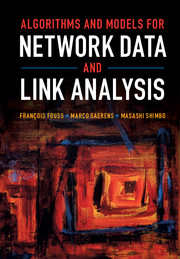Crossref Citations
This Book has been
cited by the following publications. This list is generated based on data provided by Crossref.
Mealy, Penny
Farmer, J. Doyne
and
Teytelboym, Alexander
2017.
A New Interpretation of the Economic Complexity Index.
SSRN Electronic Journal,
Ivashkin, Vladimir
and
Chebotarev, Pavel
2017.
Models, Algorithms, and Technologies for Network Analysis.
Vol. 197,
Issue. ,
p.
87.
Knoll, Julian
Köckritz, David
and
Groß, Rainer
2017.
Innovations for Community Services.
Vol. 717,
Issue. ,
p.
87.
Avrachenkov, Konstantin
Chebotarev, Pavel
and
Rubanov, Dmytro
2017.
Algorithms and Models for the Web Graph.
Vol. 10519,
Issue. ,
p.
27.
Corbellini, Alejandro
Godoy, Daniela
Mateos, Cristian
Zunino, Alejandro
and
Lizarralde, Ignacio
2017.
Mining Social Web Service Repositories for Social Relationships to Aid Service Discovery.
p.
75.
Sommer, Felix
Fouss, François
and
Saerens, Marco
2017.
Artificial Neural Networks and Machine Learning – ICANN 2017.
Vol. 10614,
Issue. ,
p.
423.
Riascos, A P
Michelitsch, T M
Collet, B A
Nowakowski, A F
and
Nicolleau, F C G A
2018.
Random walks with long-range steps generated by functions of Laplacian matrices.
Journal of Statistical Mechanics: Theory and Experiment,
Vol. 2018,
Issue. 4,
p.
043404.
Berenhaut, Kenneth S.
Barr, Peter S.
Kogel, Alyssa M.
and
Melvin, Ryan L.
2018.
Cluster-based network proximities for arbitrary nodal subsets.
Scientific Reports,
Vol. 8,
Issue. 1,
Batagelj, Vladimir
2018.
Encyclopedia of Social Network Analysis and Mining.
p.
1.
Pachev, Benjamin
and
Webb, Benjamin
2018.
Fast link prediction for large networks using spectral embedding.
Journal of Complex Networks,
Vol. 6,
Issue. 1,
p.
79.
Carpio, Ronaldo
and
Guo, Meixin
2018.
Specialization in Investor Information and the Diversification Discount.
SSRN Electronic Journal ,
Lecron, Fabian
and
Fouss, François
2018.
An optimization model for collaborative recommendation using a covariance-based regularizer.
Data Mining and Knowledge Discovery,
Vol. 32,
Issue. 3,
p.
651.
Ceré, Raphaël
and
Egloff, Mattia
2018.
An illustrated approach to Soft Textual Cartography.
Applied Network Science,
Vol. 3,
Issue. 1,
Batagelj, Vladimir
2018.
Encyclopedia of Social Network Analysis and Mining.
p.
1943.
Egloff, Mattia
and
Ceré, Raphaël
2018.
Complex Networks & Their Applications VI.
Vol. 689,
Issue. ,
p.
731.
TÜRKEL, Selin
2018.
Sivil Toplum Kuruluşu İtibarının İnsan Biçimcilik Yaklaşımı ile Ölçümü: Bir Anlamsal Ağ Analizi.
Türkiye İletişim Araştırmaları Dergisi,
p.
77.
Peel, Leto
Delvenne, Jean-Charles
and
Lambiotte, Renaud
2018.
Multiscale mixing patterns in networks.
Proceedings of the National Academy of Sciences,
Vol. 115,
Issue. 16,
p.
4057.
Guex, Guillaume
Kivimäki, Ilkka
and
Saerens, Marco
2019.
Randomized optimal transport on a graph: framework and new distance measures.
Network Science,
Vol. 7,
Issue. 1,
p.
88.
Lambiotte, Renaud
2019.
Temporal Network Theory.
p.
219.
De Deyne, Simon
Navarro, Danielle J.
Perfors, Amy
Brysbaert, Marc
and
Storms, Gert
2019.
The “Small World of Words” English word association norms for over 12,000 cue words.
Behavior Research Methods,
Vol. 51,
Issue. 3,
p.
987.



